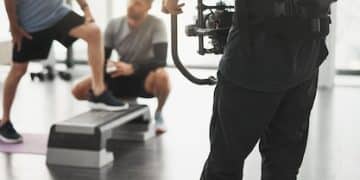Recover Faster: Optimal Active Recovery for Muscle Repair

Engaging in optimal active recovery routines is crucial for accelerating muscle repair and reducing post-exercise soreness, significantly enhancing athletic performance and overall physical well-being through improved blood flow and nutrient delivery.
In the pursuit of peak physical performance, the focus often lies on intense training sessions and pushing physical limits. However, what happens after the weights are racked and the sweat dries? The often-overlooked secret ingredient to continuous progress and injury prevention is a well-structured active recovery routine. To truly recover faster: the active recovery routine for muscle repair stands as a cornerstone for any serious athlete or fitness enthusiast.
Understanding Active Recovery
Active recovery involves performing low-intensity exercises after strenuous physical activity or during rest days. Unlike passive recovery, which signifies complete rest, active recovery leverages gentle movement to facilitate physiological processes that aid in muscle repair and soreness reduction. The underlying principle is to maintain an elevated heart rate, albeit at a much lower intensity, to promote blood flow without adding significant stress to the body.
The benefits extend beyond mere muscle repair, influencing overall athletic longevity and performance. By accelerating the removal of metabolic byproducts, reducing inflammation, and increasing nutrient delivery to fatigued muscles, active recovery prepares the body more efficiently for subsequent training sessions. This proactive approach to post-exercise care is essential for anyone committed to a consistent and effective fitness regimen.
The Science Behind Active Recovery
The human body is an intricate machine, and its recovery mechanisms are complex. After intense exercise, muscles undergo micro-tears, leading to inflammation and the accumulation of metabolic waste products like lactic acid. While full rest allows the body to restore itself, active recovery speeds up these processes by promoting circulation.
- Enhanced Blood Flow: Gentle movement increases blood flow to the muscles, delivering oxygen and essential nutrients necessary for tissue repair.
- Waste Product Removal: Improved circulation helps flush out metabolic byproducts such as lactic acid, hydrogen ions, and other waste that contribute to muscle soreness and fatigue.
- Reduced Muscle Soreness (DOMS): By mitigating inflammation and accelerating waste removal, active recovery can significantly alleviate delayed onset muscle soreness (DOMS).
- Neuromuscular Facilitation: Light activity can help maintain neurological pathways and muscle activation patterns, preventing stiffness and enhancing readiness for the next workout.
Understanding these physiological responses highlights why incorporating active recovery is not just beneficial, but a critical component of a holistic training plan designed for optimal muscle repair and long-term athletic health.
Key Principles of an Effective Active Recovery Routine
To maximize the benefits of active recovery, it’s crucial to adhere to specific principles that ensure the exercises are restorative rather than taxing. The overarching goal is to support the body’s natural healing processes without inducing further fatigue or injury. This means paying close attention to intensity, duration, and the types of activities chosen.
An effective routine is one that feels good, promotes a sense of well-being, and leaves you feeling refreshed. If an active recovery session feels like another workout, it defeats its purpose. It should be a gentle, deliberate effort to aid recovery, not impede it.
Intensity and Duration Guidelines
The cornerstone of successful active recovery lies in maintaining a low intensity. The effort level should be minimal, typically within 40-60% of your maximum heart rate. This ensures that the body is working just enough to stimulate blood flow and waste removal without creating new muscle damage or depleting energy reserves.
- Low Intensity: You should be able to comfortably hold a conversation throughout the entire active recovery session. This is often referred to as the “talk test.”
- Moderate Duration: Sessions typically range from 15 to 30 minutes. Shorter durations might not provide sufficient circulatory benefits, while longer ones risk becoming a workout.
- Listen to Your Body: The most crucial guideline is subjective. If an activity feels too strenuous, reduce the intensity or choose a different exercise.
The balance of duration and intensity is delicate, and it requires self-awareness. Beginners might opt for shorter durations at first, gradually increasing as their body adapts and becomes more accustomed to the gentle movement.
Choosing the Right Activities
The selection of activities for active recovery is diverse, allowing for personalization based on individual preferences and the type of strenuous exercise performed. The key is to select movements that are low-impact, promote fluidity, and engage muscles gently.
Ideal activities are those that allow for continuous, rhythmic movement without excessive strain. They should not challenge your strength or cardiovascular capacity significantly but rather facilitate blood flow and muscular relaxation.
- Walking: A brisk walk is one of the simplest and most accessible forms of active recovery, engaging large muscle groups without impact.
- Light Cycling: Cycling on a stationary bike or outdoors at a low resistance can provide excellent circulatory benefits.
- Swimming or Water Aerobics: The buoyancy of water makes these activities extremely low-impact, ideal for sore joints and muscles.
- Yoga or Pilates (Gentle Flow): Focusing on flexibility, mobility, and controlled movements, these practices can reduce stiffness and improve body awareness.
- Foam Rolling and Stretching: While not cardiovascular, these aid in releasing muscle tension and improving range of motion, complementing active recovery.
Varying active recovery activities can prevent boredom and ensure different muscle groups receive attention. The aim is always to leave the session feeling better than when you started, ready to tackle the next challenge.
Integrating Active Recovery into Your Training Schedule
Successfully implementing active recovery requires strategic planning within your broader training schedule. It’s not just about doing an activity; it’s about doing it at the right time and with the right mindset. Whether it’s post-workout or on a designated rest day, consistency is key to reaping the benefits.
Consider active recovery as an integral part of your training, not an optional add-on. Just as you plan your intense workouts, dedicate specific slots for recovery to ensure it becomes a habitual and effective component of your fitness journey.

Post-Workout Cooldowns
Immediately after an intense workout, a brief active cooldown is invaluable. This phase helps transition the body from a high-stress state to a recovery mode, gradually bringing down heart rate and body temperature. It also provides an immediate opportunity to begin flushing out metabolic waste.
A typical post-workout cooldown should last 5-10 minutes and involve very light versions of the exercises performed, or general low-impact activities. For instance, after a run, a slow walk or light jog is appropriate. After weightlifting, light cardio like cycling or dynamic stretching helps.
The goal is to prevent blood pooling, reduce the risk of muscle cramps, and facilitate the start of the repair process. This seemingly small effort has a significant cumulative effect on overall recovery.
Active Recovery on Rest Days
Rest days are not synonymous with complete inactivity for many athletes. Instead, they present an ideal opportunity for active recovery, allowing the body to heal and adapt without the high demands of intense training. This approach helps maintain fitness levels while promoting recovery.
Dedicate 20-30 minutes on a rest day to a chosen active recovery activity. This could be a leisurely bike ride, a slow swim, or a gentle yoga session. The key is to keep the intensity low to avoid turning a rest day into another training day.
Incorporating active recovery on rest days can also serve as a mental break, reducing the pressure to perform while still feeling productive and committed to your fitness goals. It’s about smart training, not just hard training.
Common Pitfalls to Avoid
While active recovery offers numerous benefits, it’s possible to undermine its effectiveness by making common mistakes. Understanding these pitfalls and how to avoid them ensures that your efforts truly contribute to muscle repair and overall well-being, rather than hindering it.
The line between beneficial active recovery and an inadvertently taxing workout can be fine. Awareness and adherence to the principles of low intensity are paramount. It’s about listening to your body and respecting its needs during the recovery phase.
Overdoing the Intensity
Perhaps the most prevalent mistake in active recovery is pushing the intensity too high. This negates the purpose of recovery, as high-intensity efforts can create new muscle damage, increase inflammation, and exacerbate fatigue, effectively turning a recovery session into another training session.
Remember the “talk test”: if you can’t comfortably maintain a conversation, you’re working too hard. The goal is to facilitate blood flow, not to challenge your cardiovascular system or muscular endurance. Keep your heart rate low and your breath relatively even.
Resist the urge to push past the comfortable zone, even if you feel energetic. The long-term benefits of proper recovery outweigh the short-term satisfaction of a slightly more intense session.
Ignoring Body Signals
The body provides clear signals, especially when it’s fatigued or overtrained. Ignoring these cues during active recovery can lead to injury or prolonged soreness. If a particular movement causes pain, or if you feel unusually tired, it’s crucial to adjust or stop.
Pain is an alarm system. Distinguish between mild discomfort (like a gentle stretch) and sharp pain. Active recovery should feel restorative, not painful. If you’re experiencing unusual soreness or signs of overtraining, complete rest might be more appropriate than active recovery.
Developing body awareness is a continuous process. Pay attention to how different activities feel and how your body responds. This attunement allows for smarter, more effective recovery strategies.
Lack of Consistency
Sporadic active recovery efforts yield minimal results. Like any training component, consistency is vital. Regular incorporation of active recovery, whether daily or a few times a week, builds cumulative benefits that significantly impact long-term muscle repair and athletic performance.
Work active recovery into your schedule just as you would your main workouts. Even short, consistent efforts are more effective than infrequent, long sessions. Making it a habitual part of your routine reinforces its importance and ensures its benefits accumulate over time.
Consistency also allows your body to adapt better to the recovery process, making each subsequent session more effective and integrated into your overall physical well-being strategy.
Advanced Active Recovery Techniques
Beyond traditional low-intensity activities, several advanced techniques can complement an active recovery routine, further enhancing muscle repair and reducing soreness. These methods often involve specialized equipment or practices that target specific aspects of recovery.
While not strictly “active” in the sense of movement, these techniques are often integrated into an athlete’s routine to optimize the recovery environment, making them highly relevant to the overall goal of recovering faster. They work by addressing fascial restrictions, improving circulation, and promoting relaxation.
Foam Rolling and Self-Myofascial Release
Foam rolling and other self-myofascial release (SMR) techniques involve applying pressure to specific points on the body to release muscle tightness and knots (trigger points). This can mimic the effects of a deep tissue massage, improving blood flow and flexibility.
- Targeted Pressure: Use a foam roller, massage ball, or similar tool to apply pressure to tight or sore areas.
- Improved Flexibility: Releasing fascial restrictions can enhance range of motion and reduce stiffness.
- Enhanced Circulation: The pressure and release actions can stimulate blood flow to the targeted muscles, aiding in nutrient delivery and waste removal.
Incorporate SMR before or after an active recovery session, or as a standalone practice. Hold pressure on tender spots for 30-60 seconds, or gently roll back and forth over the muscle.
Compression Garments
Compression garments (socks, sleeves, shorts) are designed to provide graduated pressure to various body parts. While their direct impact on performance is debated, many athletes report subjective benefits regarding recovery and reduced muscle soreness.
The theory suggests that compression can enhance blood flow and reduce muscle oscillation during activity, potentially minimizing muscle damage. Post-exercise, they are thought to assist in venous return and reduce swelling.
Wearing compression garments during or after active recovery can be a comfortable way to potentially aid muscle circulation and reduce the feeling of tired legs or arms.
Contrast Therapy (Hot and Cold)
Contrast therapy involves alternating between hot and cold applications, such as hot and cold showers or ice baths followed by warm baths. This technique is believed to create a “pumping” action in the blood vessels, promoting circulation and waste removal.
The rapid changes in temperature cause blood vessels to constrict (cold) and dilate (heat), which in theory, flushes metabolites and reduces inflammation. While the scientific evidence is mixed, many athletes find it an invigorating and subjectively beneficial recovery method.
If considering contrast therapy, start with short exposures and gradually increase duration as tolerated. Always prioritize safety and listen to your body’s response.
Nutrition and Hydration for Optimized Recovery
While movement is central to active recovery, the body’s internal environment is equally crucial for muscle repair. Proper nutrition and hydration provide the essential building blocks and medium for physiological processes, significantly influencing how quickly and effectively muscles recover.
Neglecting diet and fluid intake can undermine even the most diligent active recovery efforts. Think of nutrition and hydration as the fuel and lubricant for your body’s recovery machinery. Without them, the engine simply won’t run efficiently.

Macronutrient Timing and Intake
The quantity and timing of macronutrients (proteins, carbohydrates, fats) play a pivotal role in post-exercise recovery. After strenuous activity, muscles are primed to absorb nutrients, making this a critical window for replenishment.
- Protein: Essential for muscle protein synthesis (repair and growth). Aim for 20-40 grams of high-quality protein within 30-60 minutes post-workout, and ensure consistent intake throughout the day.
- Carbohydrates: Replenish glycogen stores depleted during exercise. Consuming carbohydrates with protein further aids recovery by promoting insulin release, which helps drive amino acids into muscle cells.
- Fats: While not as immediately critical post-workout, healthy fats are important for hormone production and overall cellular health.
A balanced meal or snack combining these macronutrients post-exercise creates an optimal environment for muscle repair and preparation for the next session. This strategic fueling supports the body’s ability to adapt and recover efficiently.
The Importance of Hydration
Dehydration can severely impair performance and recovery. Water is involved in virtually every bodily function, including nutrient transport, temperature regulation, and waste removal. Even mild dehydration can lead to fatigue, reduced endurance, and impaired cognitive function.
During exercise, significant fluid and electrolyte loss occurs through sweat. Replenishing these losses is paramount. Not just water, but also electrolytes like sodium and potassium, are often needed, especially after long or intense sessions.
Consistent hydration throughout the day, not just around workouts, is key. Monitor urine color (pale yellow indicates good hydration) and aim to drink consistently. For longer sessions (over an hour) or heavy sweating, consider electrolyte-fortified beverages.
Sleep and Stress Management: Beyond Physical Recovery
True recovery extends beyond physical aspects; mental and hormonal recovery are equally vital. Sleep is arguably the single most powerful recovery tool available, while effective stress management can mitigate the systemic impact of chronic physiological and psychological strain. These elements are non-negotiable for anyone serious about optimizing muscle repair and overall well-being.
The body repairs and rebuilds most effectively when it is resting deeply. Similarly, uncontrolled stress can flood the system with cortisol, a hormone that can counteract recovery and even promote muscle breakdown. Addressing these non-physical factors creates a more holistic recovery environment.
The Power of Quality Sleep
During deep sleep stages, the body releases growth hormone, which is crucial for tissue repair and regeneration. This is also when glucose metabolism stabilizes, and the central nervous system recovers. Inadequate sleep can lead to hormonal imbalances, increased inflammation, and impaired glucose regulation, all of which hinder recovery and performance.
Aim for 7-9 hours of quality sleep per night. Establish a consistent sleep schedule, create a conducive sleep environment (dark, quiet, cool), and avoid screens and heavy meals before bed. Prioritizing sleep is not a luxury; it’s a fundamental requirement for anyone engaging in regular physical activity.
A well-rested body is a resilient body, better equipped to repair muscle damage, replenish energy stores, and adapt to training demands.
Stress Management Techniques
Chronic stress, whether from training, work, or personal life, can elevate cortisol levels. Persistently high cortisol can promote muscle breakdown, suppress the immune system, and interfere with sleep, thereby directly impeding recovery. Managing stress is therefore an active component of a comprehensive recovery strategy.
Incorporate stress-reducing practices into your daily routine:
- Mindfulness and Meditation: Even a few minutes a day can reduce perceived stress and improve relaxation.
- Deep Breathing Exercises: Simple techniques can activate the parasympathetic nervous system, promoting a state of calm.
- Hobbies and Social Connection: Engaging in enjoyable activities and nurturing relationships can provide mental breaks and reduce overall stress load.
- Time Management: Organizing tasks and setting realistic expectations can alleviate feelings of overwhelm.
By proactively managing stress, you create an internal environment more conducive to growth and repair, allowing your active recovery efforts to truly flourish and contribute to a faster, more effective muscle repair process.
| Key Point | Brief Description |
|---|---|
| 🏃♂️ Active Movement | Low-intensity exercise post-workout or on rest days to boost circulation and waste removal. |
| 💧 Hydration & Nutrition | Crucial for replenishing nutrients, supporting muscle repair, and maintaining bodily functions. |
| 😴 Quality Sleep | Essential for hormonal balance, tissue repair, and central nervous system recovery. |
| 🧘♀️ Stress Management | Minimizes cortisol’s negative effects, supporting overall physiological recovery. |
Frequently Asked Questions About Active Recovery
▼
The main purpose of active recovery is to promote blood flow without inducing further muscle damage or fatigue. This enhanced circulation helps to flush metabolic byproducts, deliver essential nutrients and oxygen to tired muscles, thereby accelerating muscle repair and reducing delayed onset muscle soreness (DOMS), preparing the body for future strenuous activities.
▼
Passive recovery involves complete rest, where the body is entirely inactive. In contrast, active recovery involves light, low-intensity movement. While both allow the body to heal, active recovery is thought to speed up the process by actively enhancing blood circulation, clearing waste products more efficiently, and maintaining a degree of muscle pliability.
▼
Effective active recovery exercises are typically low-impact and low-intensity. Examples include brisk walking, light cycling on a stationary bike, gentle swimming or water aerobics, and restorative yoga or Pilates. The key is to choose activities that allow you to maintain a conversation and do not add significant stress or strain to your muscles.
▼
An active recovery session typically lasts between 15 to 30 minutes, depending on the individual’s fitness level and the intensity of the preceding workout. Shorter durations may not provide sufficient circulatory benefits, while longer sessions risk becoming too strenuous. The most important factor is listening to your body and stopping if you feel any discomfort or fatigue.
▼
While active recovery may not entirely prevent DOMS, it can significantly reduce its severity and duration. By improving blood flow and aiding in the removal of metabolic waste products that contribute to soreness, active recovery helps to mitigate the inflammatory response and accelerate muscle tissue repair, allowing for a quicker return to full function.
Conclusion
The journey to peak physical fitness and long-term athletic health is not just about intense training; it’s equally about smart, effective recovery. An optimal active recovery routine for muscle repair is a powerful, yet often undervalued, component of this journey. By strategically incorporating low-intensity activities, prioritizing nutrition, hydration, quality sleep, and managing stress, athletes and fitness enthusiasts can significantly accelerate muscle repair, reduce soreness, and enhance overall performance and resilience. Embracing active recovery is a commitment to your body’s longevity and its ability to continually adapt and excel.





